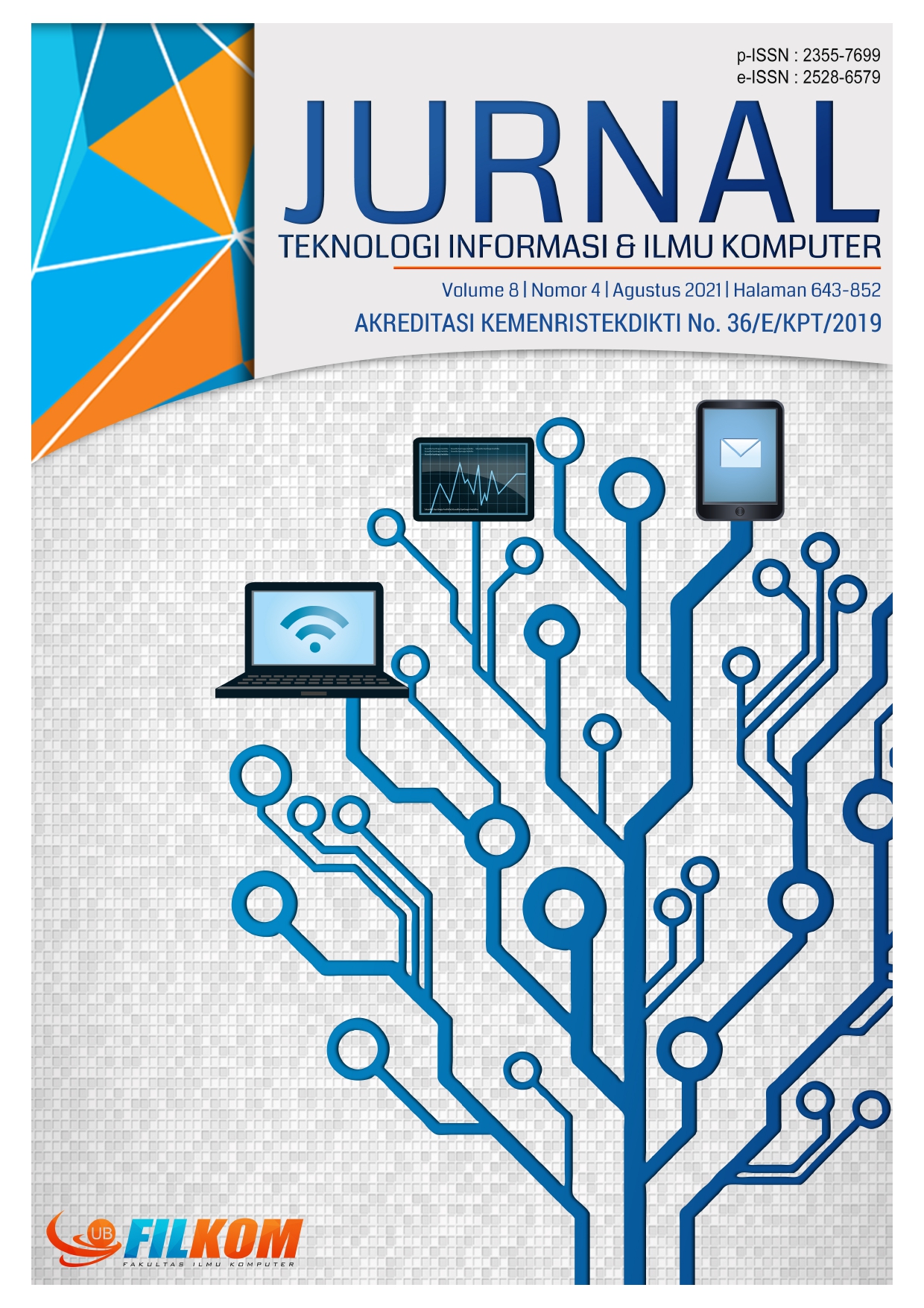Pengenalan Ras Berdasarkan Hidung Dan Mulut Menggunakan Gray Level Co-Occurrence Matrix
DOI:
https://doi.org/10.25126/jtiik.2021844366Abstrak
Ras dapat digunakan untuk mengkategorikan manusia dalam populasi atau kelompok besar. Oleh karena itu, pengenalan ras dapat berguna untuk mempermudah dalam mengidentifikasi seseorang dan membantu dalam mempersempit lingkup pencarian. Penggunaan wajah sebagai dasar pengenalan ras mengarahkan penelitian pada identifikasi penggunaan bagian wajah yang berpengaruh signifikan terhadap kinerja pengenalan ras. Pada penelitian ini bagian wajah berupa hidung dan mulut diidentifikasi untuk digunakan sebagai dasar pengenalan ras Mongoloid, Kaukasoid, dan Negroid. Ciri Gray Level Co-occurrence Matrix (GLCM) diekstrak dari bagian hidung dan mulut untuk selanjutnya diklasifikasi menggunakan Random Forest. Hasil eksperimen menunjukkan bahwa penggunaan ciri gabungan dari hidung dan mulut mampu menghasilkan kinerja sistem yang paling baik jika dibandingkan penggunaan hidung atau mulut saja.
Abstract
Race can be used to categorize humans in populations or large groups. Therefore, racial recognition can be useful to make it easier to identify a person and help narrow the scope of the search. The use of faces as a basis for race recognition directs research on identifying the use of facial parts that significantly influence the performance of race recognition. In this study, the face parts of the nose and mouth were identified to be used as a basis for the recognition of the Mongoloid, Caucasoid, and Negroid races. The Gray Level Co-occurrence Matrix (GLCM) feature is extracted from the nose and mouth to be classified using Random Forest. The experimental results show that the use of combined features of the nose and mouth is able to produce the best system performance compared to the use of the nose or mouth only.
Downloads
Referensi
ALRASHED, H. F., dan BERBAR, M. A., 2013. Facial Gender Recognition Using Eyes Images. Int. J. Adv. Res. Comput. Commun. Eng., vol. 2, no. 6, pp. 2441–2445.
BOYSEENS, A. dan VIRIRI, S. B., 2016. Component-Based Ethnicity Identification. pp. 293–303.
BIANCONI, F., SMERALDI, F., ABDOLLAHYAN, M., dan XIAO, P., 2016. On the use of skin texture features for gender recognition : an experimental evaluation.
BREIMAN, L., 2001. Random Forests, Mach. Learn., vol. 45, no. 1, pp. 5–32
ELEYAN, A. dan DEMIREL, H., 2011. Co-occurrence matrix and its statistical features as a new approach for face recognition. Turk J Elec Eng Comp Sci, vol. 19, no. 1, pp. 97–107.
HARALICK, R. M., SHANMUGAM, K., dan DINSTEIN, I., 1973. Textural features for image classification. IEEE Trans. Syst. Man. Cybern., vol. SMC-3, no. 6, pp. 610–621
HLAING, K. N. N. dan GOPALAKRISHNAN, A. K., 2016. Myanmar paper currency recognition using GLCM and k-NN. 2016 2nd Asian Conference on Defence Technology, ACDT 2016.
HOSOI, S., TAKIKAWA, E., dan KAWADE, M., 2004. Ethnicity estimation with facial images. Proceedings - Sixth IEEE International Conference on Automatic Face and Gesture Recognition.
MANESH, F.S., GHAHRAMANI, M., dan TAN, Y. P., 2010. Facial part displacement effect on template-based gender and ethnicity classification. 11th International Conference on Control, Automation, Robotics and Vision, ICARCV 2010.
MASOOD, S., GUPTA, S., WAJID, A., GUPTA, S., dan AHMED, M., 2018. Prediction of human ethnicity from facial images using neural networks. Advances in Intelligent Systems and Computing, vol. 542, pp. 217–226.
MOMIN, H. dan TAPAMO, J. R., 2016. A comparative study of a face components based model of ethnic classification using gabor filters. Appl. Math. Inf. Sci., vol. 10, no. 6, pp. 2255–2265,.
REHMAN, A., KHAN, G., SIDDIQI, A., KHAN, A., dan KHAN, U. G., 2018. Modified texture features from histogram and gray level co-occurence matrix of facial data for ethnicity detection. 5th International Multi-Topic ICT Conference: Technologies For Future Generations, IMTIC 2018 - Proceedings, pp. 1–6.
STHEVANIE, F., RAMADHANI, K. N., dan RASYID, H. F., 2018. Klasifikasi Ras Mongoloid Berbasis Citra Wajah menggunakan Algoritma k-Nearest Neighbors. Indones. J. Comput., vol. 3, no. 1, p. 45.
YANG, Z. dan AI, H., 2007. Demographic classification with local binary patterns. Lecture Notes in Computer Science (including subseries Lecture Notes in Artificial Intelligence and Lecture Notes in Bioinformatics).
VIOLA, P. dan JONES, M., 2001. Rapid object detection using a boosted cascade of simple features. Proceedings of the IEEE Computer Society Conference on Computer Vision and Pattern Recognition, , vol. 1.
Unduhan
Diterbitkan
Terbitan
Bagian
Lisensi

Artikel ini berlisensi Creative Common Attribution-ShareAlike 4.0 International (CC BY-SA 4.0)
Penulis yang menerbitkan di jurnal ini menyetujui ketentuan berikut:
- Penulis menyimpan hak cipta dan memberikan jurnal hak penerbitan pertama naskah secara simultan dengan lisensi di bawah Creative Common Attribution-ShareAlike 4.0 International (CC BY-SA 4.0) yang mengizinkan orang lain untuk berbagi pekerjaan dengan sebuah pernyataan kepenulisan pekerjaan dan penerbitan awal di jurnal ini.
- Penulis bisa memasukkan ke dalam penyusunan kontraktual tambahan terpisah untuk distribusi non ekslusif versi kaya terbitan jurnal (contoh: mempostingnya ke repositori institusional atau menerbitkannya dalam sebuah buku), dengan pengakuan penerbitan awalnya di jurnal ini.
- Penulis diizinkan dan didorong untuk mem-posting karya mereka online (contoh: di repositori institusional atau di website mereka) sebelum dan selama proses penyerahan, karena dapat mengarahkan ke pertukaran produktif, seperti halnya sitiran yang lebih awal dan lebih hebat dari karya yang diterbitkan. (Lihat Efek Akses Terbuka).














